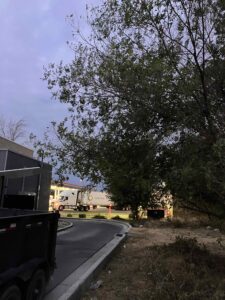When you live in an area with lots of trees, there’s a chance you might face a tree emergency sooner or later. It could be a storm that leaves a tree leaning dangerously close to your house, or maybe a branch breaks and dangles over your car. In times like these, you need a swift and reliable solution, and that’s where a tree removal service near me comes into play.
In this article, we’ll guide you through the steps to take when faced with a tree emergency. We’ll cover how to recognize the signs of a tree emergency, what immediate actions to take, how to contact an emergency tree removal service, what to expect during the removal process, and how to prepare for any future tree emergencies. So, let’s dive in and ensure you’re well-prepared for any tree crisis that comes your way.
Recognizing the Signs of a Tree Emergency
1. Identifying Hazardous Tree Conditions
The first step in handling a tree emergency is being able to spot it. Look out for these signs:
- Leaning Trees: If you notice a tree suddenly leaning more than it used to, especially towards your home or a busy area, it’s a sign of trouble. It could be due to weakened roots or a shifting foundation.
- Cracked or Split Trunks: A tree with a cracked or split trunk is unstable and poses a significant risk. Even if it hasn’t fallen yet, it could at any moment.
- Hanging or Broken Branches: A branch hanging loosely or broken but still attached is a potential danger. It might fall unexpectedly, causing harm or damage.
2. Assessing the Proximity of the Tree to Structures or Power Lines
Consider how close the tree is to your home, garage, car, power lines, or other important structures. If a tree falls in the wrong direction, it can cause severe damage or even be life-threatening.
3. Importance of Regular Tree Inspections
Regular tree inspections by a certified arborist can help you catch potential hazards before they become emergencies. They can assess the health of your trees and recommend necessary actions, such as pruning or removal, to prevent accidents.
Immediate Steps to Take in a Tree Emergency
1. Safety First: Protecting Yourself and Others
In a tree emergency, your safety is paramount. Here’s what you should do:
- Evacuate the Area: If you suspect that a tree is about to fall or there’s immediate danger, get everyone, including pets, out of harm’s way.
- Call 911 If There’s Immediate Danger: If the situation is life-threatening or involves downed power lines, call 911 immediately.
2. Notifying Relevant Authorities or Utility Companies
In case a fallen tree affects power lines or poses a threat to public safety, inform the appropriate authorities or utility companies. They can respond promptly to ensure safety and restore services.
3. Documenting the Emergency
If it’s safe to do so, take photos or videos of the emergency situation. This documentation can be helpful when you need to file an insurance claim or share information with an emergency tree removal service.
Contacting Emergency Tree Removal Services
Now that you’ve taken immediate safety measures, it’s time to contact a professional tree removal service near me. Here’s what you need to know:
Why It’s Crucial to Call Professionals
Emergency tree removal is not a DIY task. It requires expertise, specialized equipment, and safety measures. Professional tree removal services have trained arborists who can assess the situation, plan the removal, and execute it safely.
Tips for Finding and Selecting a Reputable Emergency Tree Removal Service
- Check for Certification: Ensure that the tree removal service you choose is certified and insured. This demonstrates their commitment to safety and professionalism.
- Read Reviews and Ask for Recommendations: Look for online reviews and ask friends or neighbors for recommendations. Positive testimonials from satisfied customers can provide peace of mind.
- Request Estimates: Contact multiple tree removal services to request estimates. This will help you compare prices and services to make an informed decision.
Providing Accurate Location Information
When you call an emergency tree removal service, be sure to provide accurate location information. This includes your address, landmarks, and any specific details about the tree’s location on your property.
Communicating with the Tree Removal Team
Once you’ve contacted a tree removal service, here’s what you can expect:
What to Expect When You Call for Help
When you call an emergency tree removal service, they will likely ask you a series of questions to assess the situation. Be prepared to describe the emergency, its location, and any potential hazards.
Sharing Details About the Situation
Provide as much information as possible about the tree emergency. Mention if there are power lines involved or if the tree has damaged any structures. This information helps the removal team plan their approach.
Asking Questions and Requesting Estimates
Don’t hesitate to ask questions about the removal process, safety measures, and the estimated timeline. Request a written estimate that includes all expected costs to avoid any surprises.
Understanding the Timeline and Process
The tree removal team will provide an estimated timeline for their arrival. Understand that during severe weather events or widespread emergencies, response times may be longer. Stay patient and stay safe.
Preparing Your Property for Tree Removal
While you wait for the tree removal team, there are some steps you can take to prepare your property:
Clearing the Area Around the Tree
Remove any obstacles or debris from the area around the tree. This will make it easier for the tree removal team to access the site safely.
Securing Valuable or Sensitive Items
If the tree emergency has caused damage to your property, take steps to secure valuable or sensitive items to prevent further harm.
Making Arrangements for Pets or Livestock
Ensure the safety of your pets or livestock by moving them to a secure location away from the tree emergency site.
The Tree Removal Process
Once the tree removal team arrives, they will take the following steps:
Steps Involved in Emergency Tree Removal
- Assessment: The team will assess the tree and the surrounding area to determine the best approach for removal.
- Safety Measures: Safety is a priority. The team will set up safety barriers and use personal protective equipment.
- Equipment Setup: Specialized equipment such as chainsaws, cranes, and ropes may be used to safely remove the tree.
- Tree Removal: The removal process will be carefully executed, taking into account the tree’s size, position, and potential hazards.
Potential Challenges and How They Are Addressed
During the tree removal process, unexpected challenges may arise. These could include hidden decay or structural issues in the tree. Experienced arborists are trained to handle such situations safely.
Aftermath and Cleanup
Once the tree has been successfully removed, there are a few things to consider:
Assessing the Damage (If Any) to Your Property
Inspect your property for any damage caused by the tree emergency or the removal process. Document any issues you find for insurance purposes.
Post-Removal Inspections and Recommendations
After the tree has been removed, consider having an arborist inspect the remaining trees on your property. They can recommend further actions to ensure your landscape’s safety.
Discussing Insurance Coverage for Tree Emergencies
Contact your homeowner’s insurance provider to discuss coverage for tree emergencies. They can advise you on the steps to take for filing a claim if applicable.
Preventative Measures for Future Tree Emergencies
While you’ve successfully resolved the current tree emergency, it’s essential to take steps to prevent future incidents:
Regular Tree Maintenance and Inspections
Schedule regular inspections by a certified arborist. They can identify potential hazards and provide recommendations for maintenance or removal.
Pruning and Trimming to Reduce Risks
Regular pruning and trimming can help maintain the health and structural integrity of your trees, reducing the risk of emergencies.
Tips for Choosing the Right Tree Species for Your Property
When planting new trees, choose species that are well-suited to your area and won’t pose significant risks as they mature.
Conclusion
In times of a tree emergency, knowing what to do can make all the difference. By recognizing the signs of a tree emergency, taking immediate safety measures, and contacting a professional tree removal service near you, like Go and Grow Tree Co in Orem, UT at 801-722-8154, we can ensure the safety of your property and loved ones from potential harm. Remember that safety should always be your top priority, and when in doubt, seek the assistance of trained experts to handle tree emergencies safely and effectively. Go and Grow Tree Co is your trusted partner in times of tree crises, providing swift and reliable tree removal services to address your emergency needs.



